Evaluating Tesla's Global Strategy, Sustainability, and Ethics
VerifiedAdded on 2023/06/05
|20
|3856
|350
Report
AI Summary
This report provides a comprehensive analysis of Tesla's global strategy and sustainability initiatives. It examines the internal and external business environments using models like PESTLE and SWOT, evaluates foreign market entry strategies, and analyzes the use of horizontal and vertical integration, as well as outsourcing alliances. The report further assesses Tesla's corporate social responsibility (CSR) strategy, identifies ethical issues faced by the company, and offers recommendations for improvement. The analysis aims to provide insights into Tesla's strategic decisions and their impact on the company's growth and sustainability efforts within the global market. Desklib offers a variety of solved assignments and past papers for students.
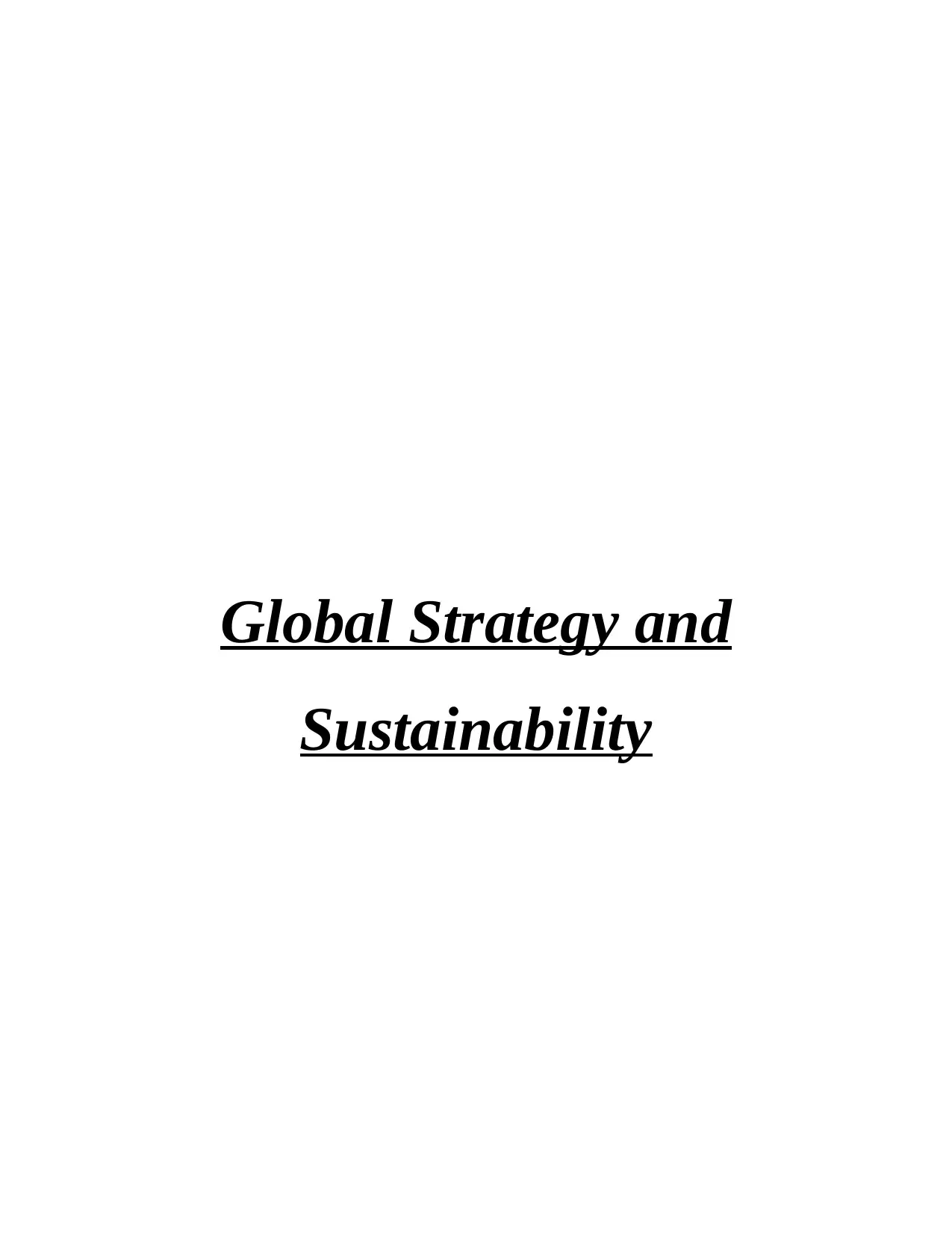
Global Strategy and
Sustainability
Sustainability
Secure Best Marks with AI Grader
Need help grading? Try our AI Grader for instant feedback on your assignments.
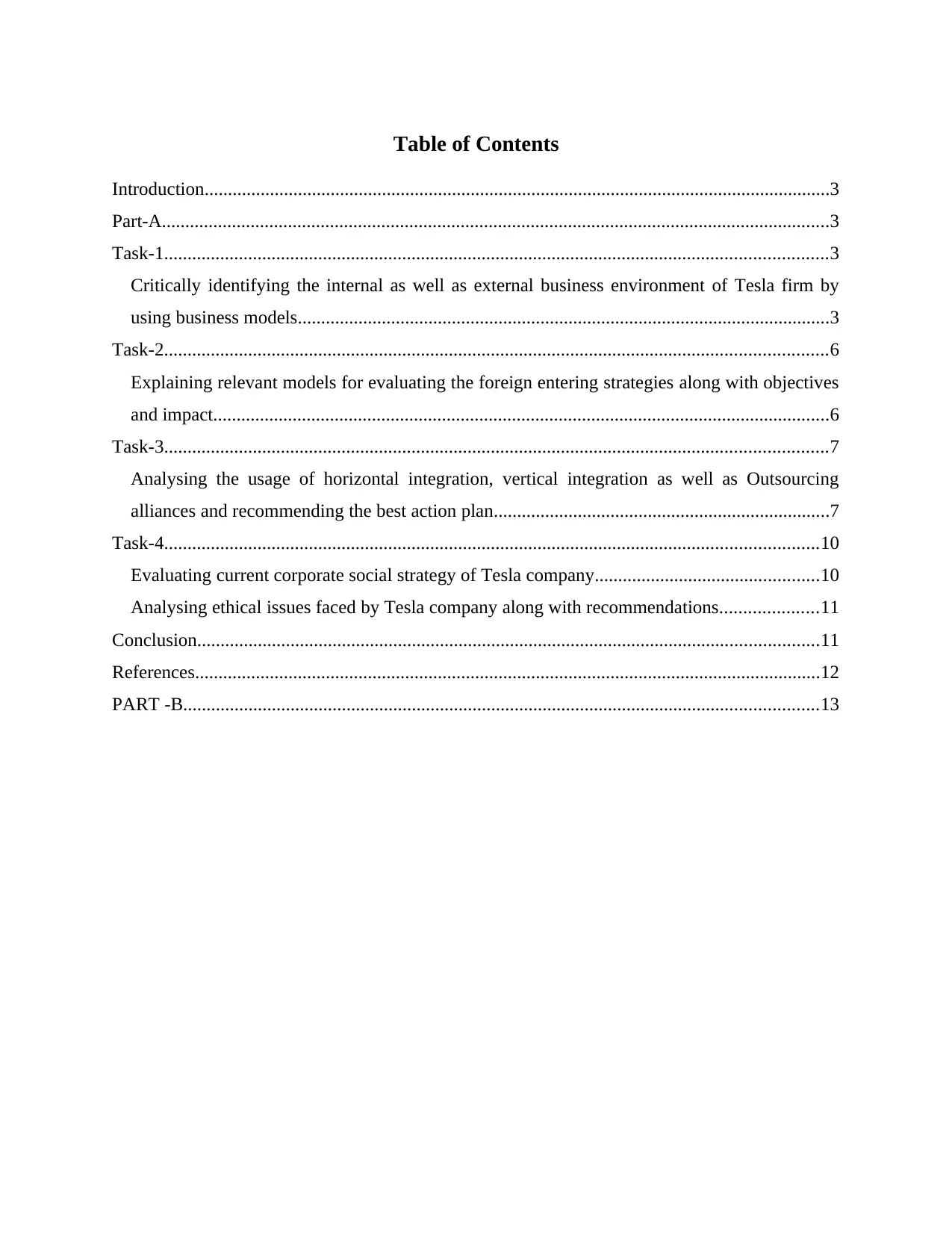
Table of Contents
Introduction......................................................................................................................................3
Part-A...............................................................................................................................................3
Task-1..............................................................................................................................................3
Critically identifying the internal as well as external business environment of Tesla firm by
using business models..................................................................................................................3
Task-2..............................................................................................................................................6
Explaining relevant models for evaluating the foreign entering strategies along with objectives
and impact....................................................................................................................................6
Task-3..............................................................................................................................................7
Analysing the usage of horizontal integration, vertical integration as well as Outsourcing
alliances and recommending the best action plan........................................................................7
Task-4............................................................................................................................................10
Evaluating current corporate social strategy of Tesla company................................................10
Analysing ethical issues faced by Tesla company along with recommendations.....................11
Conclusion.....................................................................................................................................11
References......................................................................................................................................12
PART -B........................................................................................................................................13
Introduction......................................................................................................................................3
Part-A...............................................................................................................................................3
Task-1..............................................................................................................................................3
Critically identifying the internal as well as external business environment of Tesla firm by
using business models..................................................................................................................3
Task-2..............................................................................................................................................6
Explaining relevant models for evaluating the foreign entering strategies along with objectives
and impact....................................................................................................................................6
Task-3..............................................................................................................................................7
Analysing the usage of horizontal integration, vertical integration as well as Outsourcing
alliances and recommending the best action plan........................................................................7
Task-4............................................................................................................................................10
Evaluating current corporate social strategy of Tesla company................................................10
Analysing ethical issues faced by Tesla company along with recommendations.....................11
Conclusion.....................................................................................................................................11
References......................................................................................................................................12
PART -B........................................................................................................................................13
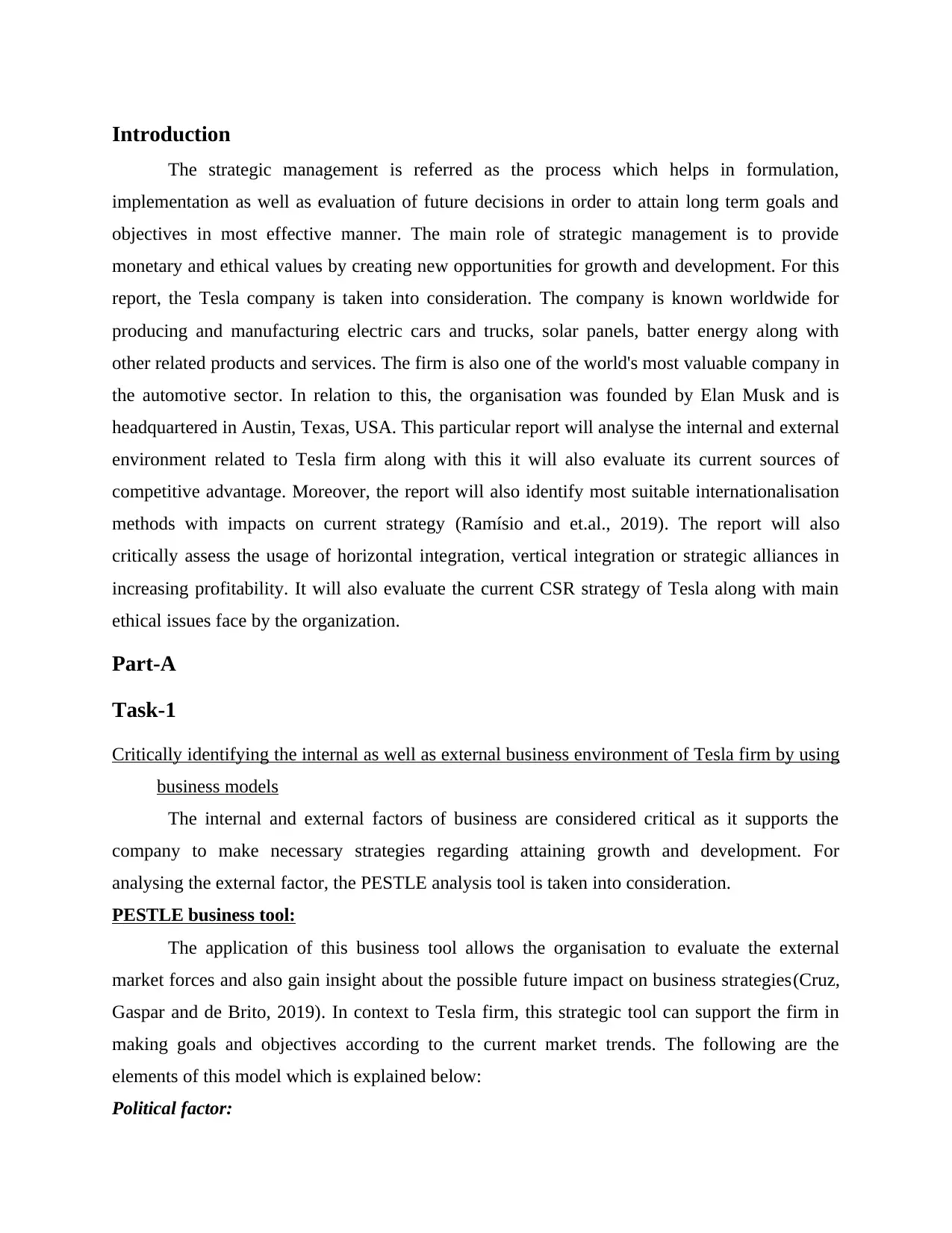
Introduction
The strategic management is referred as the process which helps in formulation,
implementation as well as evaluation of future decisions in order to attain long term goals and
objectives in most effective manner. The main role of strategic management is to provide
monetary and ethical values by creating new opportunities for growth and development. For this
report, the Tesla company is taken into consideration. The company is known worldwide for
producing and manufacturing electric cars and trucks, solar panels, batter energy along with
other related products and services. The firm is also one of the world's most valuable company in
the automotive sector. In relation to this, the organisation was founded by Elan Musk and is
headquartered in Austin, Texas, USA. This particular report will analyse the internal and external
environment related to Tesla firm along with this it will also evaluate its current sources of
competitive advantage. Moreover, the report will also identify most suitable internationalisation
methods with impacts on current strategy (Ramísio and et.al., 2019). The report will also
critically assess the usage of horizontal integration, vertical integration or strategic alliances in
increasing profitability. It will also evaluate the current CSR strategy of Tesla along with main
ethical issues face by the organization.
Part-A
Task-1
Critically identifying the internal as well as external business environment of Tesla firm by using
business models
The internal and external factors of business are considered critical as it supports the
company to make necessary strategies regarding attaining growth and development. For
analysing the external factor, the PESTLE analysis tool is taken into consideration.
PESTLE business tool:
The application of this business tool allows the organisation to evaluate the external
market forces and also gain insight about the possible future impact on business strategies(Cruz,
Gaspar and de Brito, 2019). In context to Tesla firm, this strategic tool can support the firm in
making goals and objectives according to the current market trends. The following are the
elements of this model which is explained below:
Political factor:
The strategic management is referred as the process which helps in formulation,
implementation as well as evaluation of future decisions in order to attain long term goals and
objectives in most effective manner. The main role of strategic management is to provide
monetary and ethical values by creating new opportunities for growth and development. For this
report, the Tesla company is taken into consideration. The company is known worldwide for
producing and manufacturing electric cars and trucks, solar panels, batter energy along with
other related products and services. The firm is also one of the world's most valuable company in
the automotive sector. In relation to this, the organisation was founded by Elan Musk and is
headquartered in Austin, Texas, USA. This particular report will analyse the internal and external
environment related to Tesla firm along with this it will also evaluate its current sources of
competitive advantage. Moreover, the report will also identify most suitable internationalisation
methods with impacts on current strategy (Ramísio and et.al., 2019). The report will also
critically assess the usage of horizontal integration, vertical integration or strategic alliances in
increasing profitability. It will also evaluate the current CSR strategy of Tesla along with main
ethical issues face by the organization.
Part-A
Task-1
Critically identifying the internal as well as external business environment of Tesla firm by using
business models
The internal and external factors of business are considered critical as it supports the
company to make necessary strategies regarding attaining growth and development. For
analysing the external factor, the PESTLE analysis tool is taken into consideration.
PESTLE business tool:
The application of this business tool allows the organisation to evaluate the external
market forces and also gain insight about the possible future impact on business strategies(Cruz,
Gaspar and de Brito, 2019). In context to Tesla firm, this strategic tool can support the firm in
making goals and objectives according to the current market trends. The following are the
elements of this model which is explained below:
Political factor:
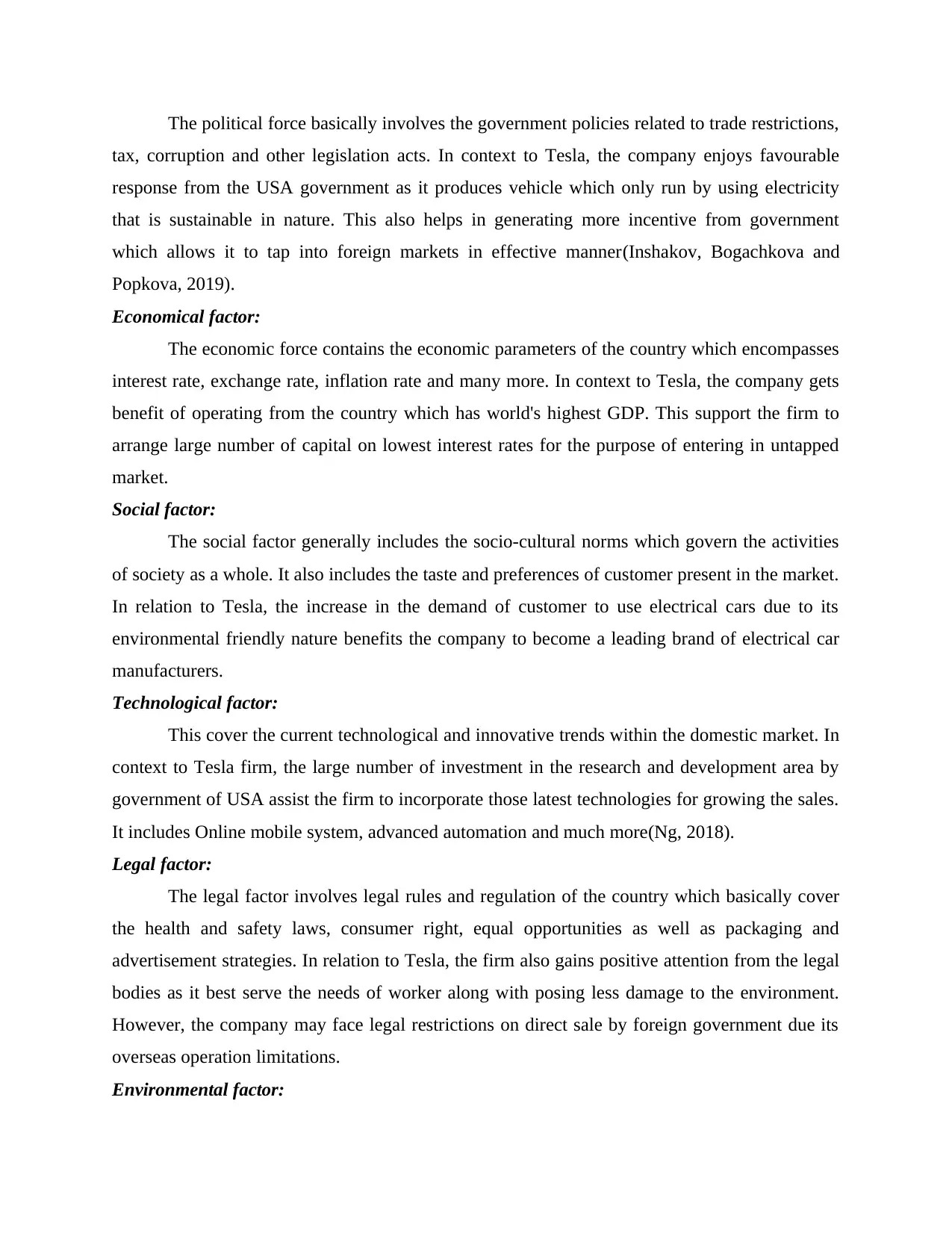
The political force basically involves the government policies related to trade restrictions,
tax, corruption and other legislation acts. In context to Tesla, the company enjoys favourable
response from the USA government as it produces vehicle which only run by using electricity
that is sustainable in nature. This also helps in generating more incentive from government
which allows it to tap into foreign markets in effective manner(Inshakov, Bogachkova and
Popkova, 2019).
Economical factor:
The economic force contains the economic parameters of the country which encompasses
interest rate, exchange rate, inflation rate and many more. In context to Tesla, the company gets
benefit of operating from the country which has world's highest GDP. This support the firm to
arrange large number of capital on lowest interest rates for the purpose of entering in untapped
market.
Social factor:
The social factor generally includes the socio-cultural norms which govern the activities
of society as a whole. It also includes the taste and preferences of customer present in the market.
In relation to Tesla, the increase in the demand of customer to use electrical cars due to its
environmental friendly nature benefits the company to become a leading brand of electrical car
manufacturers.
Technological factor:
This cover the current technological and innovative trends within the domestic market. In
context to Tesla firm, the large number of investment in the research and development area by
government of USA assist the firm to incorporate those latest technologies for growing the sales.
It includes Online mobile system, advanced automation and much more(Ng, 2018).
Legal factor:
The legal factor involves legal rules and regulation of the country which basically cover
the health and safety laws, consumer right, equal opportunities as well as packaging and
advertisement strategies. In relation to Tesla, the firm also gains positive attention from the legal
bodies as it best serve the needs of worker along with posing less damage to the environment.
However, the company may face legal restrictions on direct sale by foreign government due its
overseas operation limitations.
Environmental factor:
tax, corruption and other legislation acts. In context to Tesla, the company enjoys favourable
response from the USA government as it produces vehicle which only run by using electricity
that is sustainable in nature. This also helps in generating more incentive from government
which allows it to tap into foreign markets in effective manner(Inshakov, Bogachkova and
Popkova, 2019).
Economical factor:
The economic force contains the economic parameters of the country which encompasses
interest rate, exchange rate, inflation rate and many more. In context to Tesla, the company gets
benefit of operating from the country which has world's highest GDP. This support the firm to
arrange large number of capital on lowest interest rates for the purpose of entering in untapped
market.
Social factor:
The social factor generally includes the socio-cultural norms which govern the activities
of society as a whole. It also includes the taste and preferences of customer present in the market.
In relation to Tesla, the increase in the demand of customer to use electrical cars due to its
environmental friendly nature benefits the company to become a leading brand of electrical car
manufacturers.
Technological factor:
This cover the current technological and innovative trends within the domestic market. In
context to Tesla firm, the large number of investment in the research and development area by
government of USA assist the firm to incorporate those latest technologies for growing the sales.
It includes Online mobile system, advanced automation and much more(Ng, 2018).
Legal factor:
The legal factor involves legal rules and regulation of the country which basically cover
the health and safety laws, consumer right, equal opportunities as well as packaging and
advertisement strategies. In relation to Tesla, the firm also gains positive attention from the legal
bodies as it best serve the needs of worker along with posing less damage to the environment.
However, the company may face legal restrictions on direct sale by foreign government due its
overseas operation limitations.
Environmental factor:
Secure Best Marks with AI Grader
Need help grading? Try our AI Grader for instant feedback on your assignments.
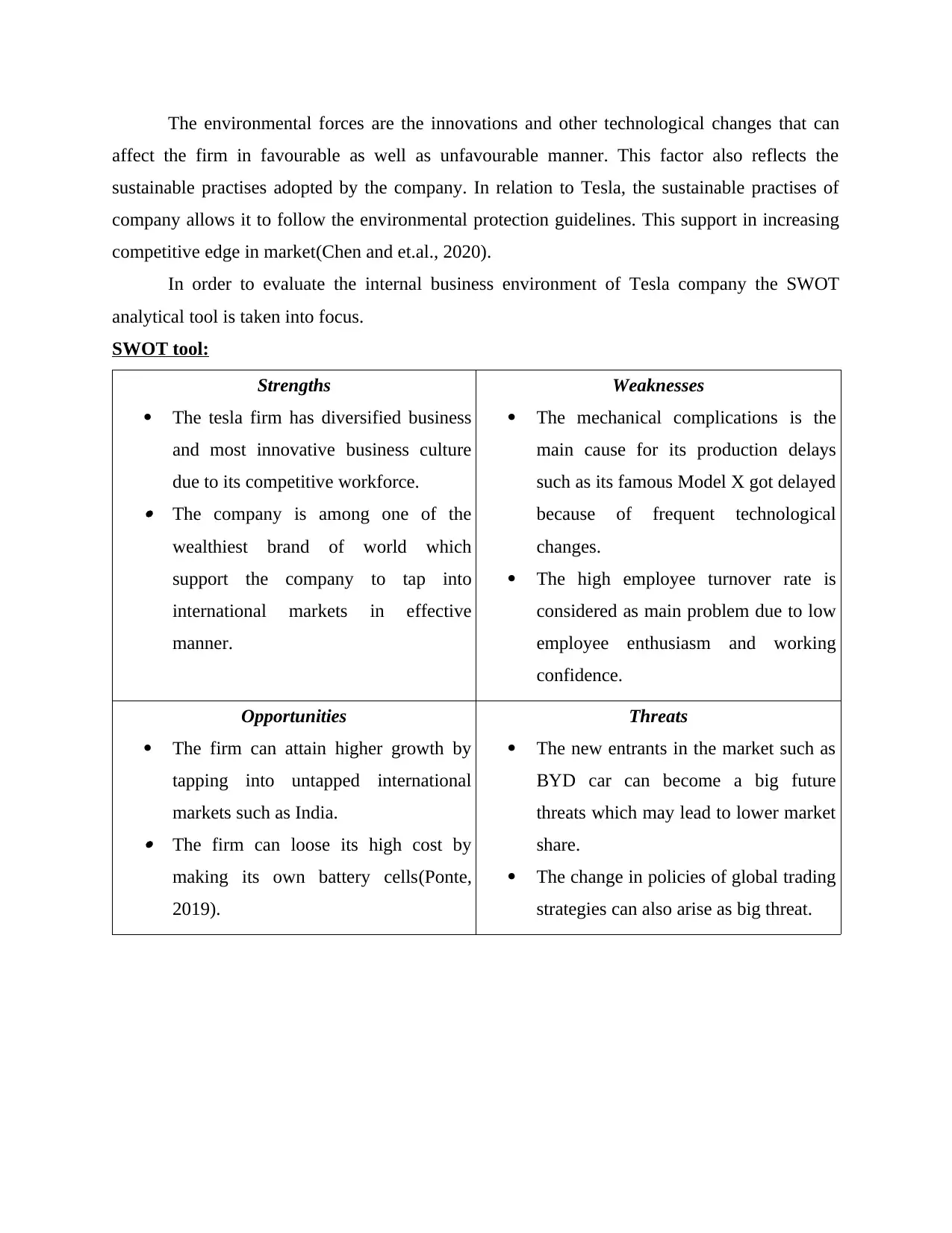
The environmental forces are the innovations and other technological changes that can
affect the firm in favourable as well as unfavourable manner. This factor also reflects the
sustainable practises adopted by the company. In relation to Tesla, the sustainable practises of
company allows it to follow the environmental protection guidelines. This support in increasing
competitive edge in market(Chen and et.al., 2020).
In order to evaluate the internal business environment of Tesla company the SWOT
analytical tool is taken into focus.
SWOT tool:
Strengths
The tesla firm has diversified business
and most innovative business culture
due to its competitive workforce. The company is among one of the
wealthiest brand of world which
support the company to tap into
international markets in effective
manner.
Weaknesses
The mechanical complications is the
main cause for its production delays
such as its famous Model X got delayed
because of frequent technological
changes.
The high employee turnover rate is
considered as main problem due to low
employee enthusiasm and working
confidence.
Opportunities
The firm can attain higher growth by
tapping into untapped international
markets such as India. The firm can loose its high cost by
making its own battery cells(Ponte,
2019).
Threats
The new entrants in the market such as
BYD car can become a big future
threats which may lead to lower market
share.
The change in policies of global trading
strategies can also arise as big threat.
affect the firm in favourable as well as unfavourable manner. This factor also reflects the
sustainable practises adopted by the company. In relation to Tesla, the sustainable practises of
company allows it to follow the environmental protection guidelines. This support in increasing
competitive edge in market(Chen and et.al., 2020).
In order to evaluate the internal business environment of Tesla company the SWOT
analytical tool is taken into focus.
SWOT tool:
Strengths
The tesla firm has diversified business
and most innovative business culture
due to its competitive workforce. The company is among one of the
wealthiest brand of world which
support the company to tap into
international markets in effective
manner.
Weaknesses
The mechanical complications is the
main cause for its production delays
such as its famous Model X got delayed
because of frequent technological
changes.
The high employee turnover rate is
considered as main problem due to low
employee enthusiasm and working
confidence.
Opportunities
The firm can attain higher growth by
tapping into untapped international
markets such as India. The firm can loose its high cost by
making its own battery cells(Ponte,
2019).
Threats
The new entrants in the market such as
BYD car can become a big future
threats which may lead to lower market
share.
The change in policies of global trading
strategies can also arise as big threat.
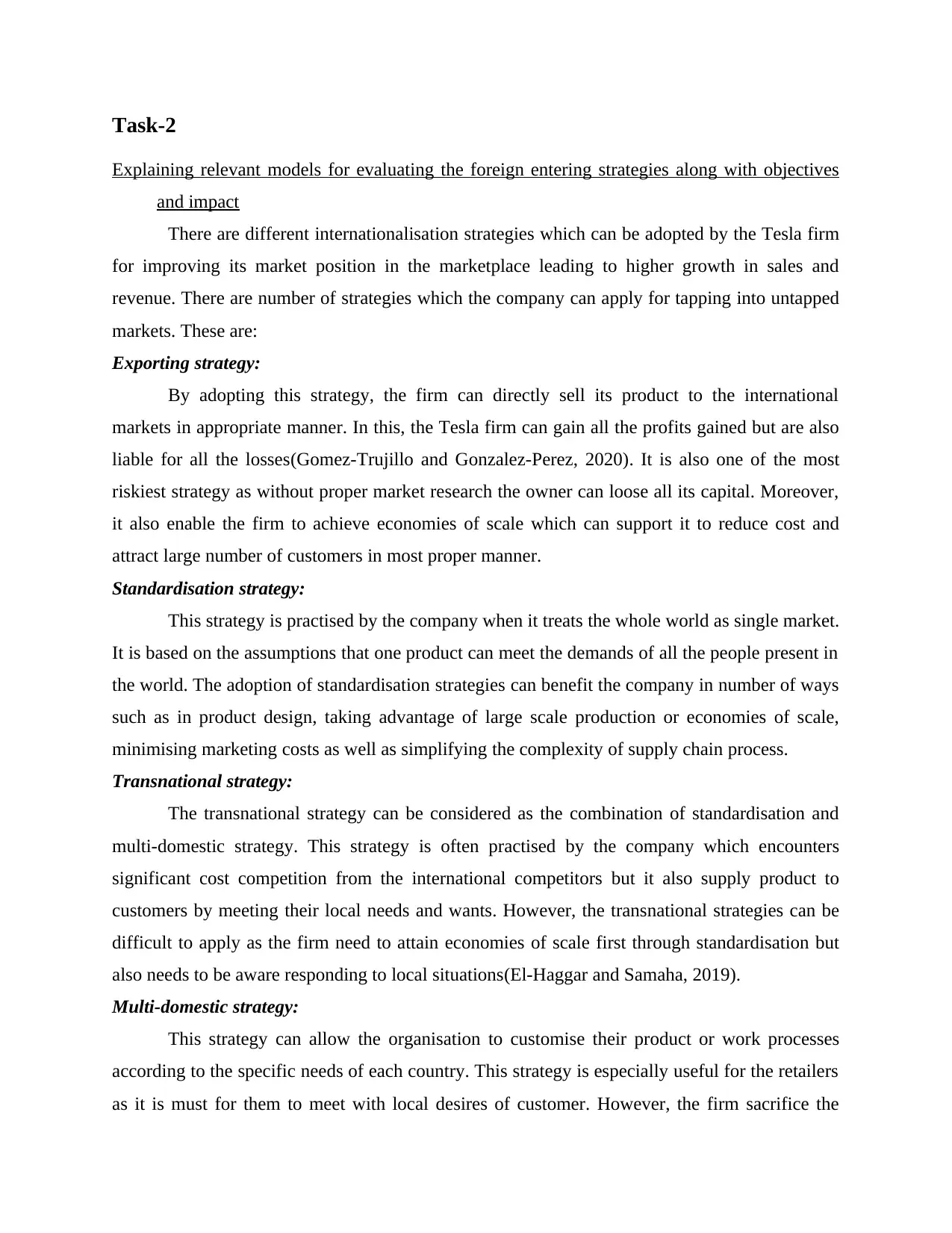
Task-2
Explaining relevant models for evaluating the foreign entering strategies along with objectives
and impact
There are different internationalisation strategies which can be adopted by the Tesla firm
for improving its market position in the marketplace leading to higher growth in sales and
revenue. There are number of strategies which the company can apply for tapping into untapped
markets. These are:
Exporting strategy:
By adopting this strategy, the firm can directly sell its product to the international
markets in appropriate manner. In this, the Tesla firm can gain all the profits gained but are also
liable for all the losses(Gomez-Trujillo and Gonzalez-Perez, 2020). It is also one of the most
riskiest strategy as without proper market research the owner can loose all its capital. Moreover,
it also enable the firm to achieve economies of scale which can support it to reduce cost and
attract large number of customers in most proper manner.
Standardisation strategy:
This strategy is practised by the company when it treats the whole world as single market.
It is based on the assumptions that one product can meet the demands of all the people present in
the world. The adoption of standardisation strategies can benefit the company in number of ways
such as in product design, taking advantage of large scale production or economies of scale,
minimising marketing costs as well as simplifying the complexity of supply chain process.
Transnational strategy:
The transnational strategy can be considered as the combination of standardisation and
multi-domestic strategy. This strategy is often practised by the company which encounters
significant cost competition from the international competitors but it also supply product to
customers by meeting their local needs and wants. However, the transnational strategies can be
difficult to apply as the firm need to attain economies of scale first through standardisation but
also needs to be aware responding to local situations(El-Haggar and Samaha, 2019).
Multi-domestic strategy:
This strategy can allow the organisation to customise their product or work processes
according to the specific needs of each country. This strategy is especially useful for the retailers
as it is must for them to meet with local desires of customer. However, the firm sacrifice the
Explaining relevant models for evaluating the foreign entering strategies along with objectives
and impact
There are different internationalisation strategies which can be adopted by the Tesla firm
for improving its market position in the marketplace leading to higher growth in sales and
revenue. There are number of strategies which the company can apply for tapping into untapped
markets. These are:
Exporting strategy:
By adopting this strategy, the firm can directly sell its product to the international
markets in appropriate manner. In this, the Tesla firm can gain all the profits gained but are also
liable for all the losses(Gomez-Trujillo and Gonzalez-Perez, 2020). It is also one of the most
riskiest strategy as without proper market research the owner can loose all its capital. Moreover,
it also enable the firm to achieve economies of scale which can support it to reduce cost and
attract large number of customers in most proper manner.
Standardisation strategy:
This strategy is practised by the company when it treats the whole world as single market.
It is based on the assumptions that one product can meet the demands of all the people present in
the world. The adoption of standardisation strategies can benefit the company in number of ways
such as in product design, taking advantage of large scale production or economies of scale,
minimising marketing costs as well as simplifying the complexity of supply chain process.
Transnational strategy:
The transnational strategy can be considered as the combination of standardisation and
multi-domestic strategy. This strategy is often practised by the company which encounters
significant cost competition from the international competitors but it also supply product to
customers by meeting their local needs and wants. However, the transnational strategies can be
difficult to apply as the firm need to attain economies of scale first through standardisation but
also needs to be aware responding to local situations(El-Haggar and Samaha, 2019).
Multi-domestic strategy:
This strategy can allow the organisation to customise their product or work processes
according to the specific needs of each country. This strategy is especially useful for the retailers
as it is must for them to meet with local desires of customer. However, the firm sacrifice the
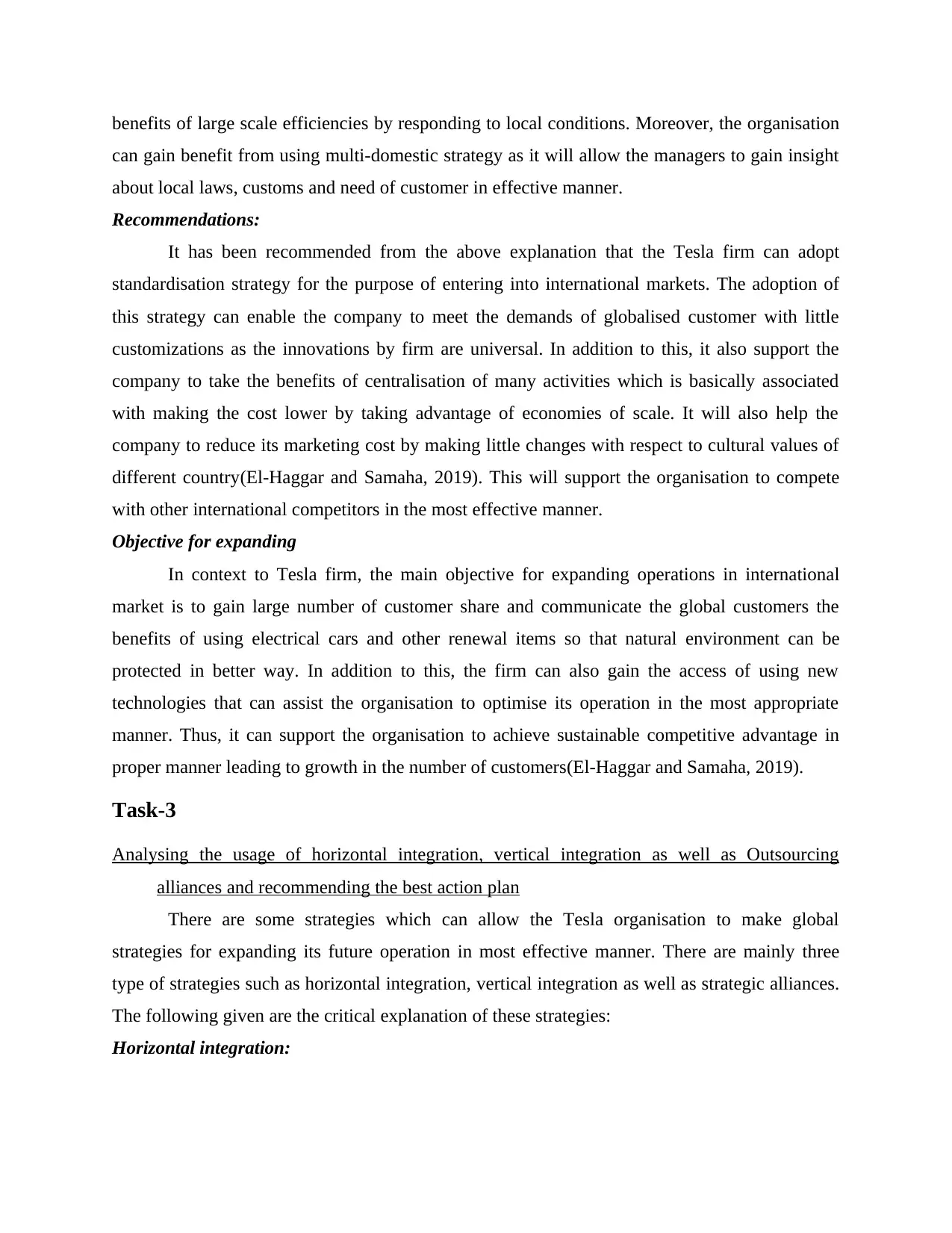
benefits of large scale efficiencies by responding to local conditions. Moreover, the organisation
can gain benefit from using multi-domestic strategy as it will allow the managers to gain insight
about local laws, customs and need of customer in effective manner.
Recommendations:
It has been recommended from the above explanation that the Tesla firm can adopt
standardisation strategy for the purpose of entering into international markets. The adoption of
this strategy can enable the company to meet the demands of globalised customer with little
customizations as the innovations by firm are universal. In addition to this, it also support the
company to take the benefits of centralisation of many activities which is basically associated
with making the cost lower by taking advantage of economies of scale. It will also help the
company to reduce its marketing cost by making little changes with respect to cultural values of
different country(El-Haggar and Samaha, 2019). This will support the organisation to compete
with other international competitors in the most effective manner.
Objective for expanding
In context to Tesla firm, the main objective for expanding operations in international
market is to gain large number of customer share and communicate the global customers the
benefits of using electrical cars and other renewal items so that natural environment can be
protected in better way. In addition to this, the firm can also gain the access of using new
technologies that can assist the organisation to optimise its operation in the most appropriate
manner. Thus, it can support the organisation to achieve sustainable competitive advantage in
proper manner leading to growth in the number of customers(El-Haggar and Samaha, 2019).
Task-3
Analysing the usage of horizontal integration, vertical integration as well as Outsourcing
alliances and recommending the best action plan
There are some strategies which can allow the Tesla organisation to make global
strategies for expanding its future operation in most effective manner. There are mainly three
type of strategies such as horizontal integration, vertical integration as well as strategic alliances.
The following given are the critical explanation of these strategies:
Horizontal integration:
can gain benefit from using multi-domestic strategy as it will allow the managers to gain insight
about local laws, customs and need of customer in effective manner.
Recommendations:
It has been recommended from the above explanation that the Tesla firm can adopt
standardisation strategy for the purpose of entering into international markets. The adoption of
this strategy can enable the company to meet the demands of globalised customer with little
customizations as the innovations by firm are universal. In addition to this, it also support the
company to take the benefits of centralisation of many activities which is basically associated
with making the cost lower by taking advantage of economies of scale. It will also help the
company to reduce its marketing cost by making little changes with respect to cultural values of
different country(El-Haggar and Samaha, 2019). This will support the organisation to compete
with other international competitors in the most effective manner.
Objective for expanding
In context to Tesla firm, the main objective for expanding operations in international
market is to gain large number of customer share and communicate the global customers the
benefits of using electrical cars and other renewal items so that natural environment can be
protected in better way. In addition to this, the firm can also gain the access of using new
technologies that can assist the organisation to optimise its operation in the most appropriate
manner. Thus, it can support the organisation to achieve sustainable competitive advantage in
proper manner leading to growth in the number of customers(El-Haggar and Samaha, 2019).
Task-3
Analysing the usage of horizontal integration, vertical integration as well as Outsourcing
alliances and recommending the best action plan
There are some strategies which can allow the Tesla organisation to make global
strategies for expanding its future operation in most effective manner. There are mainly three
type of strategies such as horizontal integration, vertical integration as well as strategic alliances.
The following given are the critical explanation of these strategies:
Horizontal integration:
Paraphrase This Document
Need a fresh take? Get an instant paraphrase of this document with our AI Paraphraser
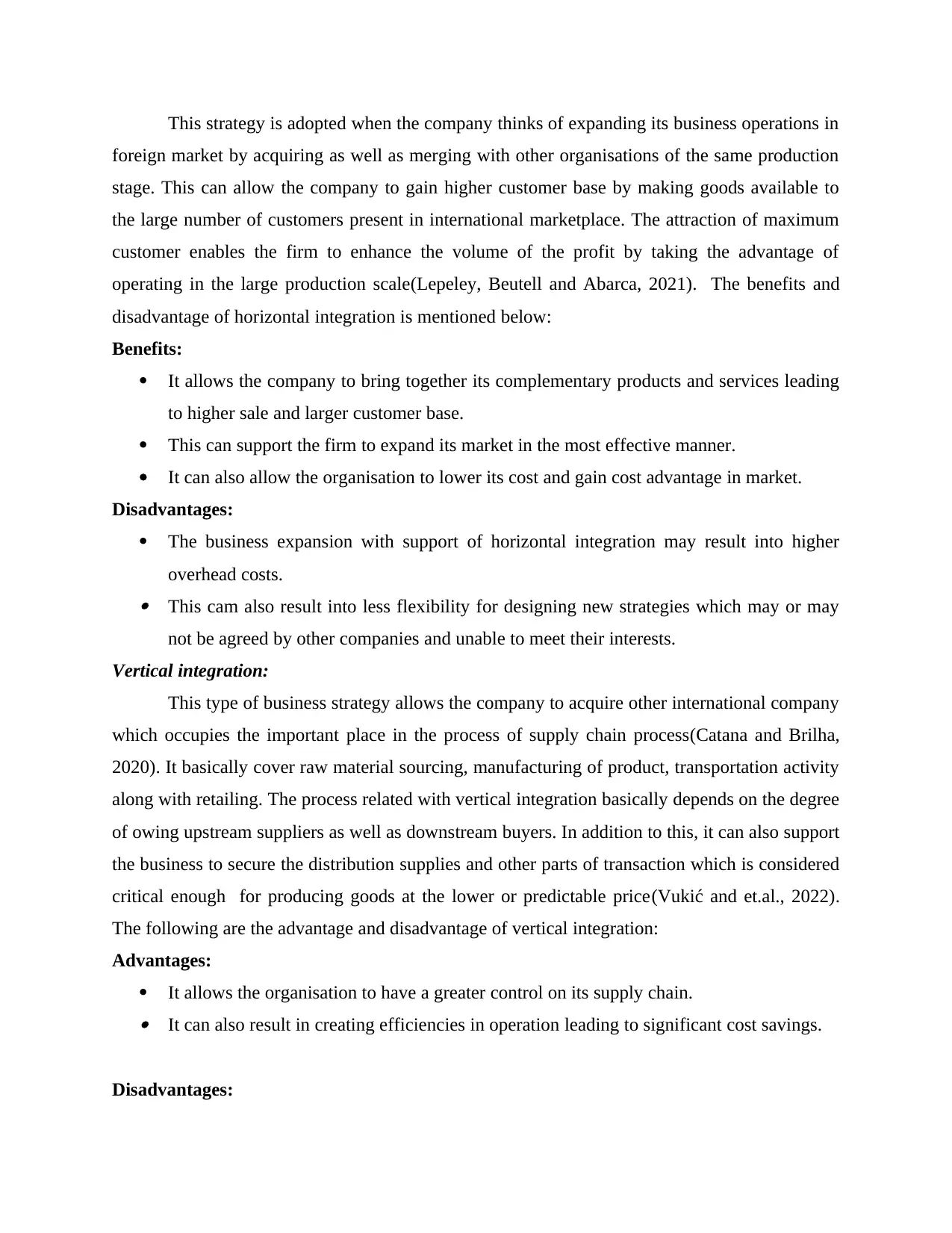
This strategy is adopted when the company thinks of expanding its business operations in
foreign market by acquiring as well as merging with other organisations of the same production
stage. This can allow the company to gain higher customer base by making goods available to
the large number of customers present in international marketplace. The attraction of maximum
customer enables the firm to enhance the volume of the profit by taking the advantage of
operating in the large production scale(Lepeley, Beutell and Abarca, 2021). The benefits and
disadvantage of horizontal integration is mentioned below:
Benefits:
It allows the company to bring together its complementary products and services leading
to higher sale and larger customer base.
This can support the firm to expand its market in the most effective manner.
It can also allow the organisation to lower its cost and gain cost advantage in market.
Disadvantages:
The business expansion with support of horizontal integration may result into higher
overhead costs. This cam also result into less flexibility for designing new strategies which may or may
not be agreed by other companies and unable to meet their interests.
Vertical integration:
This type of business strategy allows the company to acquire other international company
which occupies the important place in the process of supply chain process(Catana and Brilha,
2020). It basically cover raw material sourcing, manufacturing of product, transportation activity
along with retailing. The process related with vertical integration basically depends on the degree
of owing upstream suppliers as well as downstream buyers. In addition to this, it can also support
the business to secure the distribution supplies and other parts of transaction which is considered
critical enough for producing goods at the lower or predictable price(Vukić and et.al., 2022).
The following are the advantage and disadvantage of vertical integration:
Advantages:
It allows the organisation to have a greater control on its supply chain. It can also result in creating efficiencies in operation leading to significant cost savings.
Disadvantages:
foreign market by acquiring as well as merging with other organisations of the same production
stage. This can allow the company to gain higher customer base by making goods available to
the large number of customers present in international marketplace. The attraction of maximum
customer enables the firm to enhance the volume of the profit by taking the advantage of
operating in the large production scale(Lepeley, Beutell and Abarca, 2021). The benefits and
disadvantage of horizontal integration is mentioned below:
Benefits:
It allows the company to bring together its complementary products and services leading
to higher sale and larger customer base.
This can support the firm to expand its market in the most effective manner.
It can also allow the organisation to lower its cost and gain cost advantage in market.
Disadvantages:
The business expansion with support of horizontal integration may result into higher
overhead costs. This cam also result into less flexibility for designing new strategies which may or may
not be agreed by other companies and unable to meet their interests.
Vertical integration:
This type of business strategy allows the company to acquire other international company
which occupies the important place in the process of supply chain process(Catana and Brilha,
2020). It basically cover raw material sourcing, manufacturing of product, transportation activity
along with retailing. The process related with vertical integration basically depends on the degree
of owing upstream suppliers as well as downstream buyers. In addition to this, it can also support
the business to secure the distribution supplies and other parts of transaction which is considered
critical enough for producing goods at the lower or predictable price(Vukić and et.al., 2022).
The following are the advantage and disadvantage of vertical integration:
Advantages:
It allows the organisation to have a greater control on its supply chain. It can also result in creating efficiencies in operation leading to significant cost savings.
Disadvantages:
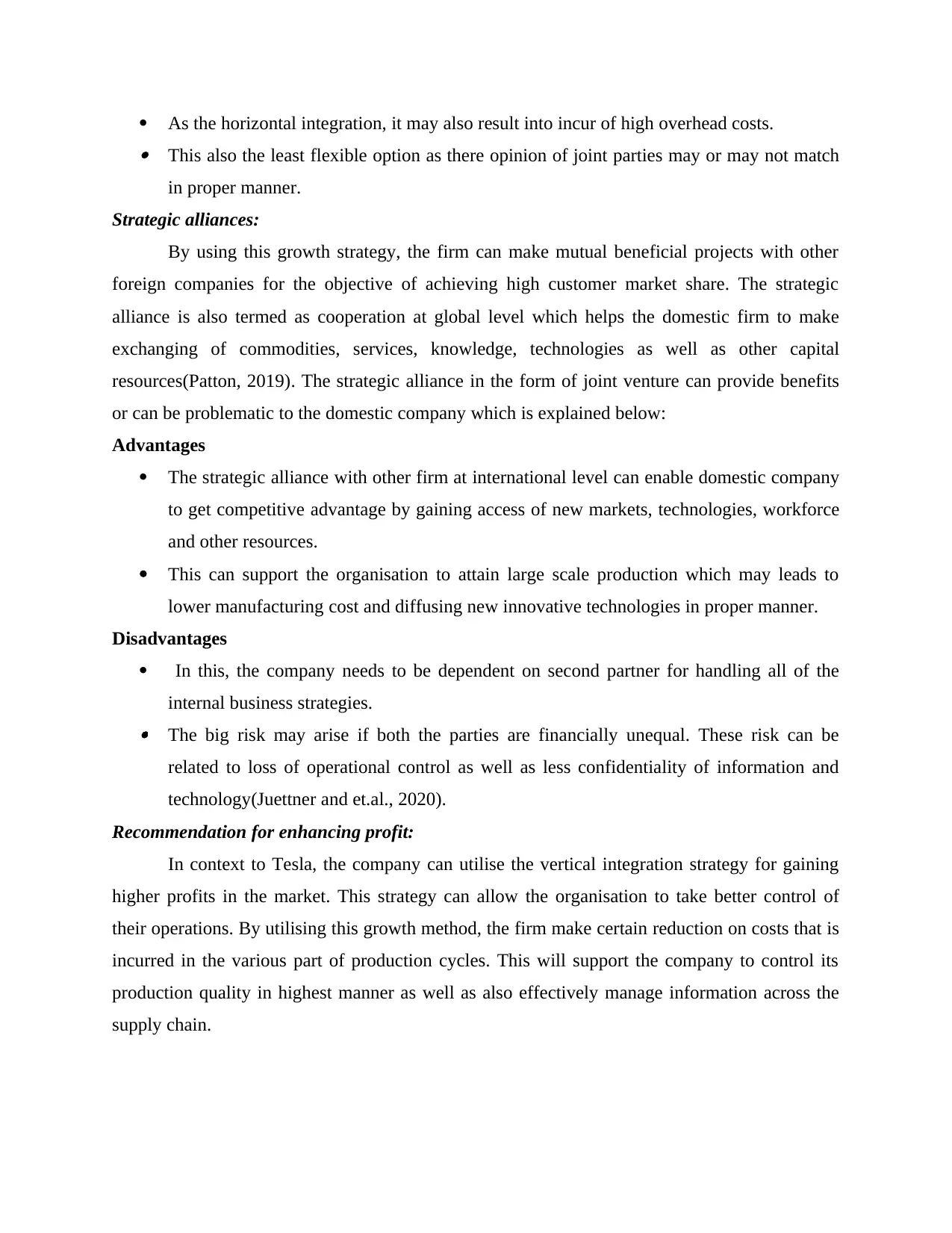
As the horizontal integration, it may also result into incur of high overhead costs. This also the least flexible option as there opinion of joint parties may or may not match
in proper manner.
Strategic alliances:
By using this growth strategy, the firm can make mutual beneficial projects with other
foreign companies for the objective of achieving high customer market share. The strategic
alliance is also termed as cooperation at global level which helps the domestic firm to make
exchanging of commodities, services, knowledge, technologies as well as other capital
resources(Patton, 2019). The strategic alliance in the form of joint venture can provide benefits
or can be problematic to the domestic company which is explained below:
Advantages
The strategic alliance with other firm at international level can enable domestic company
to get competitive advantage by gaining access of new markets, technologies, workforce
and other resources.
This can support the organisation to attain large scale production which may leads to
lower manufacturing cost and diffusing new innovative technologies in proper manner.
Disadvantages
In this, the company needs to be dependent on second partner for handling all of the
internal business strategies. The big risk may arise if both the parties are financially unequal. These risk can be
related to loss of operational control as well as less confidentiality of information and
technology(Juettner and et.al., 2020).
Recommendation for enhancing profit:
In context to Tesla, the company can utilise the vertical integration strategy for gaining
higher profits in the market. This strategy can allow the organisation to take better control of
their operations. By utilising this growth method, the firm make certain reduction on costs that is
incurred in the various part of production cycles. This will support the company to control its
production quality in highest manner as well as also effectively manage information across the
supply chain.
in proper manner.
Strategic alliances:
By using this growth strategy, the firm can make mutual beneficial projects with other
foreign companies for the objective of achieving high customer market share. The strategic
alliance is also termed as cooperation at global level which helps the domestic firm to make
exchanging of commodities, services, knowledge, technologies as well as other capital
resources(Patton, 2019). The strategic alliance in the form of joint venture can provide benefits
or can be problematic to the domestic company which is explained below:
Advantages
The strategic alliance with other firm at international level can enable domestic company
to get competitive advantage by gaining access of new markets, technologies, workforce
and other resources.
This can support the organisation to attain large scale production which may leads to
lower manufacturing cost and diffusing new innovative technologies in proper manner.
Disadvantages
In this, the company needs to be dependent on second partner for handling all of the
internal business strategies. The big risk may arise if both the parties are financially unequal. These risk can be
related to loss of operational control as well as less confidentiality of information and
technology(Juettner and et.al., 2020).
Recommendation for enhancing profit:
In context to Tesla, the company can utilise the vertical integration strategy for gaining
higher profits in the market. This strategy can allow the organisation to take better control of
their operations. By utilising this growth method, the firm make certain reduction on costs that is
incurred in the various part of production cycles. This will support the company to control its
production quality in highest manner as well as also effectively manage information across the
supply chain.
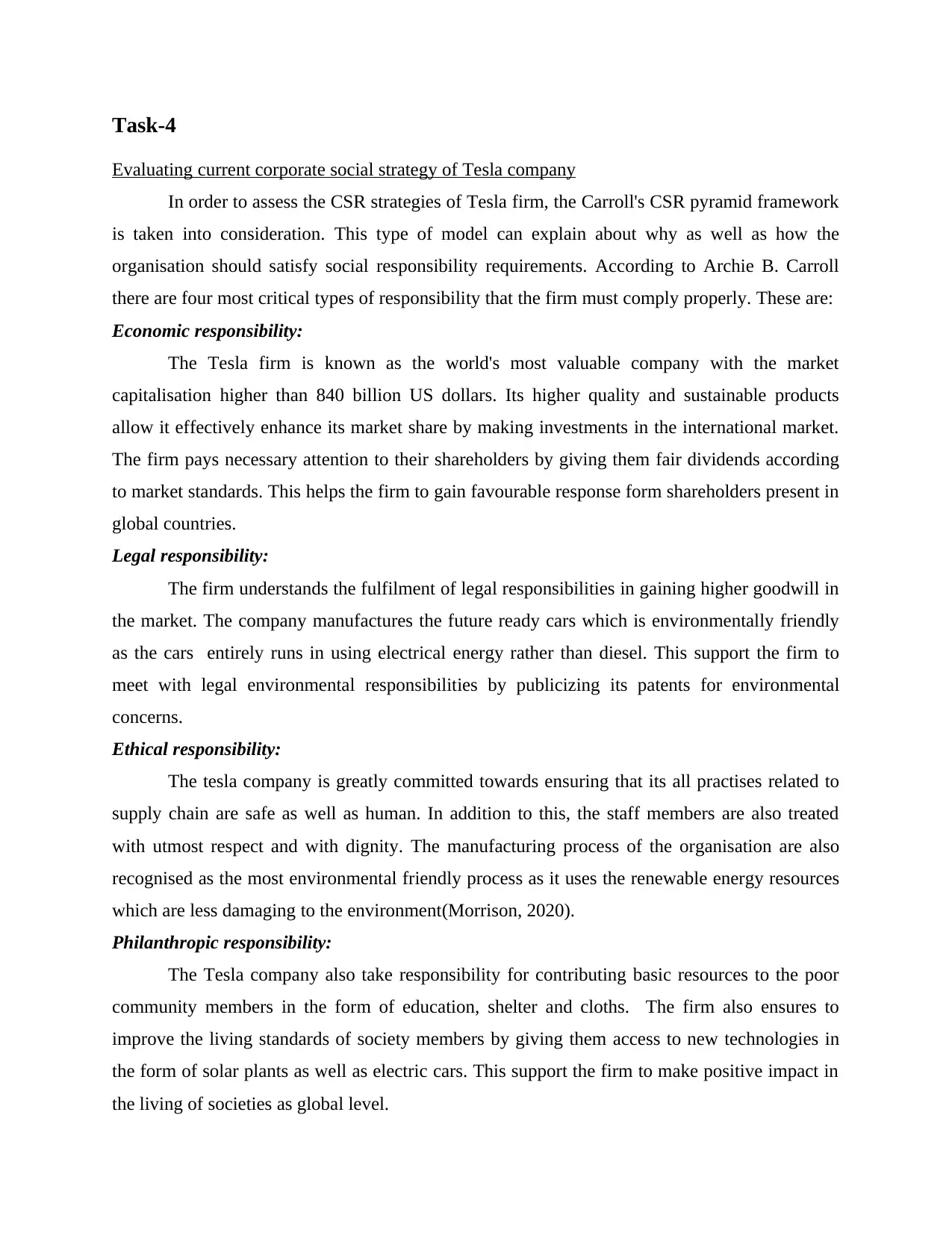
Task-4
Evaluating current corporate social strategy of Tesla company
In order to assess the CSR strategies of Tesla firm, the Carroll's CSR pyramid framework
is taken into consideration. This type of model can explain about why as well as how the
organisation should satisfy social responsibility requirements. According to Archie B. Carroll
there are four most critical types of responsibility that the firm must comply properly. These are:
Economic responsibility:
The Tesla firm is known as the world's most valuable company with the market
capitalisation higher than 840 billion US dollars. Its higher quality and sustainable products
allow it effectively enhance its market share by making investments in the international market.
The firm pays necessary attention to their shareholders by giving them fair dividends according
to market standards. This helps the firm to gain favourable response form shareholders present in
global countries.
Legal responsibility:
The firm understands the fulfilment of legal responsibilities in gaining higher goodwill in
the market. The company manufactures the future ready cars which is environmentally friendly
as the cars entirely runs in using electrical energy rather than diesel. This support the firm to
meet with legal environmental responsibilities by publicizing its patents for environmental
concerns.
Ethical responsibility:
The tesla company is greatly committed towards ensuring that its all practises related to
supply chain are safe as well as human. In addition to this, the staff members are also treated
with utmost respect and with dignity. The manufacturing process of the organisation are also
recognised as the most environmental friendly process as it uses the renewable energy resources
which are less damaging to the environment(Morrison, 2020).
Philanthropic responsibility:
The Tesla company also take responsibility for contributing basic resources to the poor
community members in the form of education, shelter and cloths. The firm also ensures to
improve the living standards of society members by giving them access to new technologies in
the form of solar plants as well as electric cars. This support the firm to make positive impact in
the living of societies as global level.
Evaluating current corporate social strategy of Tesla company
In order to assess the CSR strategies of Tesla firm, the Carroll's CSR pyramid framework
is taken into consideration. This type of model can explain about why as well as how the
organisation should satisfy social responsibility requirements. According to Archie B. Carroll
there are four most critical types of responsibility that the firm must comply properly. These are:
Economic responsibility:
The Tesla firm is known as the world's most valuable company with the market
capitalisation higher than 840 billion US dollars. Its higher quality and sustainable products
allow it effectively enhance its market share by making investments in the international market.
The firm pays necessary attention to their shareholders by giving them fair dividends according
to market standards. This helps the firm to gain favourable response form shareholders present in
global countries.
Legal responsibility:
The firm understands the fulfilment of legal responsibilities in gaining higher goodwill in
the market. The company manufactures the future ready cars which is environmentally friendly
as the cars entirely runs in using electrical energy rather than diesel. This support the firm to
meet with legal environmental responsibilities by publicizing its patents for environmental
concerns.
Ethical responsibility:
The tesla company is greatly committed towards ensuring that its all practises related to
supply chain are safe as well as human. In addition to this, the staff members are also treated
with utmost respect and with dignity. The manufacturing process of the organisation are also
recognised as the most environmental friendly process as it uses the renewable energy resources
which are less damaging to the environment(Morrison, 2020).
Philanthropic responsibility:
The Tesla company also take responsibility for contributing basic resources to the poor
community members in the form of education, shelter and cloths. The firm also ensures to
improve the living standards of society members by giving them access to new technologies in
the form of solar plants as well as electric cars. This support the firm to make positive impact in
the living of societies as global level.
Secure Best Marks with AI Grader
Need help grading? Try our AI Grader for instant feedback on your assignments.
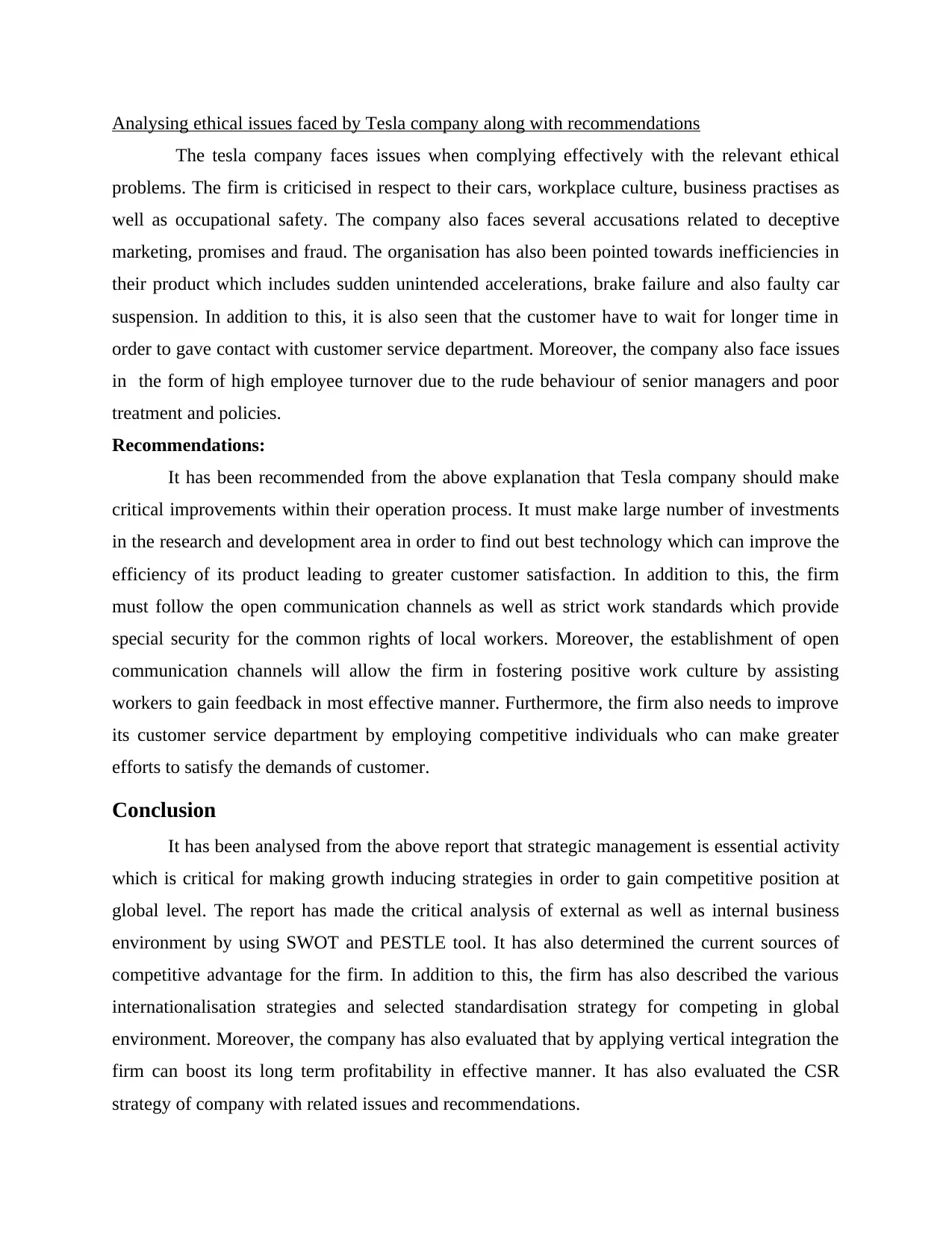
Analysing ethical issues faced by Tesla company along with recommendations
The tesla company faces issues when complying effectively with the relevant ethical
problems. The firm is criticised in respect to their cars, workplace culture, business practises as
well as occupational safety. The company also faces several accusations related to deceptive
marketing, promises and fraud. The organisation has also been pointed towards inefficiencies in
their product which includes sudden unintended accelerations, brake failure and also faulty car
suspension. In addition to this, it is also seen that the customer have to wait for longer time in
order to gave contact with customer service department. Moreover, the company also face issues
in the form of high employee turnover due to the rude behaviour of senior managers and poor
treatment and policies.
Recommendations:
It has been recommended from the above explanation that Tesla company should make
critical improvements within their operation process. It must make large number of investments
in the research and development area in order to find out best technology which can improve the
efficiency of its product leading to greater customer satisfaction. In addition to this, the firm
must follow the open communication channels as well as strict work standards which provide
special security for the common rights of local workers. Moreover, the establishment of open
communication channels will allow the firm in fostering positive work culture by assisting
workers to gain feedback in most effective manner. Furthermore, the firm also needs to improve
its customer service department by employing competitive individuals who can make greater
efforts to satisfy the demands of customer.
Conclusion
It has been analysed from the above report that strategic management is essential activity
which is critical for making growth inducing strategies in order to gain competitive position at
global level. The report has made the critical analysis of external as well as internal business
environment by using SWOT and PESTLE tool. It has also determined the current sources of
competitive advantage for the firm. In addition to this, the firm has also described the various
internationalisation strategies and selected standardisation strategy for competing in global
environment. Moreover, the company has also evaluated that by applying vertical integration the
firm can boost its long term profitability in effective manner. It has also evaluated the CSR
strategy of company with related issues and recommendations.
The tesla company faces issues when complying effectively with the relevant ethical
problems. The firm is criticised in respect to their cars, workplace culture, business practises as
well as occupational safety. The company also faces several accusations related to deceptive
marketing, promises and fraud. The organisation has also been pointed towards inefficiencies in
their product which includes sudden unintended accelerations, brake failure and also faulty car
suspension. In addition to this, it is also seen that the customer have to wait for longer time in
order to gave contact with customer service department. Moreover, the company also face issues
in the form of high employee turnover due to the rude behaviour of senior managers and poor
treatment and policies.
Recommendations:
It has been recommended from the above explanation that Tesla company should make
critical improvements within their operation process. It must make large number of investments
in the research and development area in order to find out best technology which can improve the
efficiency of its product leading to greater customer satisfaction. In addition to this, the firm
must follow the open communication channels as well as strict work standards which provide
special security for the common rights of local workers. Moreover, the establishment of open
communication channels will allow the firm in fostering positive work culture by assisting
workers to gain feedback in most effective manner. Furthermore, the firm also needs to improve
its customer service department by employing competitive individuals who can make greater
efforts to satisfy the demands of customer.
Conclusion
It has been analysed from the above report that strategic management is essential activity
which is critical for making growth inducing strategies in order to gain competitive position at
global level. The report has made the critical analysis of external as well as internal business
environment by using SWOT and PESTLE tool. It has also determined the current sources of
competitive advantage for the firm. In addition to this, the firm has also described the various
internationalisation strategies and selected standardisation strategy for competing in global
environment. Moreover, the company has also evaluated that by applying vertical integration the
firm can boost its long term profitability in effective manner. It has also evaluated the CSR
strategy of company with related issues and recommendations.
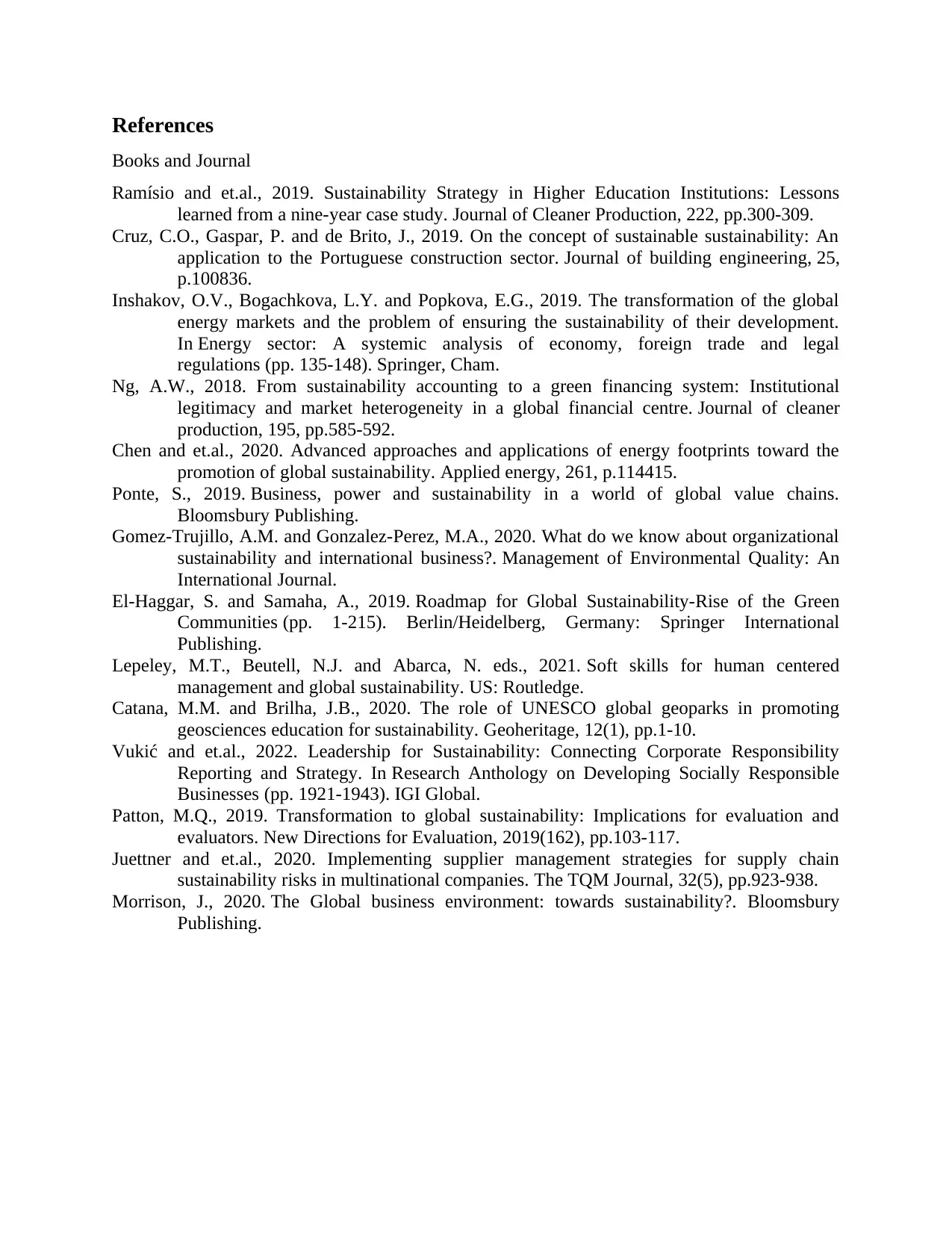
References
Books and Journal
Ramísio and et.al., 2019. Sustainability Strategy in Higher Education Institutions: Lessons
learned from a nine-year case study. Journal of Cleaner Production, 222, pp.300-309.
Cruz, C.O., Gaspar, P. and de Brito, J., 2019. On the concept of sustainable sustainability: An
application to the Portuguese construction sector. Journal of building engineering, 25,
p.100836.
Inshakov, O.V., Bogachkova, L.Y. and Popkova, E.G., 2019. The transformation of the global
energy markets and the problem of ensuring the sustainability of their development.
In Energy sector: A systemic analysis of economy, foreign trade and legal
regulations (pp. 135-148). Springer, Cham.
Ng, A.W., 2018. From sustainability accounting to a green financing system: Institutional
legitimacy and market heterogeneity in a global financial centre. Journal of cleaner
production, 195, pp.585-592.
Chen and et.al., 2020. Advanced approaches and applications of energy footprints toward the
promotion of global sustainability. Applied energy, 261, p.114415.
Ponte, S., 2019. Business, power and sustainability in a world of global value chains.
Bloomsbury Publishing.
Gomez-Trujillo, A.M. and Gonzalez-Perez, M.A., 2020. What do we know about organizational
sustainability and international business?. Management of Environmental Quality: An
International Journal.
El-Haggar, S. and Samaha, A., 2019. Roadmap for Global Sustainability-Rise of the Green
Communities (pp. 1-215). Berlin/Heidelberg, Germany: Springer International
Publishing.
Lepeley, M.T., Beutell, N.J. and Abarca, N. eds., 2021. Soft skills for human centered
management and global sustainability. US: Routledge.
Catana, M.M. and Brilha, J.B., 2020. The role of UNESCO global geoparks in promoting
geosciences education for sustainability. Geoheritage, 12(1), pp.1-10.
Vukić and et.al., 2022. Leadership for Sustainability: Connecting Corporate Responsibility
Reporting and Strategy. In Research Anthology on Developing Socially Responsible
Businesses (pp. 1921-1943). IGI Global.
Patton, M.Q., 2019. Transformation to global sustainability: Implications for evaluation and
evaluators. New Directions for Evaluation, 2019(162), pp.103-117.
Juettner and et.al., 2020. Implementing supplier management strategies for supply chain
sustainability risks in multinational companies. The TQM Journal, 32(5), pp.923-938.
Morrison, J., 2020. The Global business environment: towards sustainability?. Bloomsbury
Publishing.
Books and Journal
Ramísio and et.al., 2019. Sustainability Strategy in Higher Education Institutions: Lessons
learned from a nine-year case study. Journal of Cleaner Production, 222, pp.300-309.
Cruz, C.O., Gaspar, P. and de Brito, J., 2019. On the concept of sustainable sustainability: An
application to the Portuguese construction sector. Journal of building engineering, 25,
p.100836.
Inshakov, O.V., Bogachkova, L.Y. and Popkova, E.G., 2019. The transformation of the global
energy markets and the problem of ensuring the sustainability of their development.
In Energy sector: A systemic analysis of economy, foreign trade and legal
regulations (pp. 135-148). Springer, Cham.
Ng, A.W., 2018. From sustainability accounting to a green financing system: Institutional
legitimacy and market heterogeneity in a global financial centre. Journal of cleaner
production, 195, pp.585-592.
Chen and et.al., 2020. Advanced approaches and applications of energy footprints toward the
promotion of global sustainability. Applied energy, 261, p.114415.
Ponte, S., 2019. Business, power and sustainability in a world of global value chains.
Bloomsbury Publishing.
Gomez-Trujillo, A.M. and Gonzalez-Perez, M.A., 2020. What do we know about organizational
sustainability and international business?. Management of Environmental Quality: An
International Journal.
El-Haggar, S. and Samaha, A., 2019. Roadmap for Global Sustainability-Rise of the Green
Communities (pp. 1-215). Berlin/Heidelberg, Germany: Springer International
Publishing.
Lepeley, M.T., Beutell, N.J. and Abarca, N. eds., 2021. Soft skills for human centered
management and global sustainability. US: Routledge.
Catana, M.M. and Brilha, J.B., 2020. The role of UNESCO global geoparks in promoting
geosciences education for sustainability. Geoheritage, 12(1), pp.1-10.
Vukić and et.al., 2022. Leadership for Sustainability: Connecting Corporate Responsibility
Reporting and Strategy. In Research Anthology on Developing Socially Responsible
Businesses (pp. 1921-1943). IGI Global.
Patton, M.Q., 2019. Transformation to global sustainability: Implications for evaluation and
evaluators. New Directions for Evaluation, 2019(162), pp.103-117.
Juettner and et.al., 2020. Implementing supplier management strategies for supply chain
sustainability risks in multinational companies. The TQM Journal, 32(5), pp.923-938.
Morrison, J., 2020. The Global business environment: towards sustainability?. Bloomsbury
Publishing.
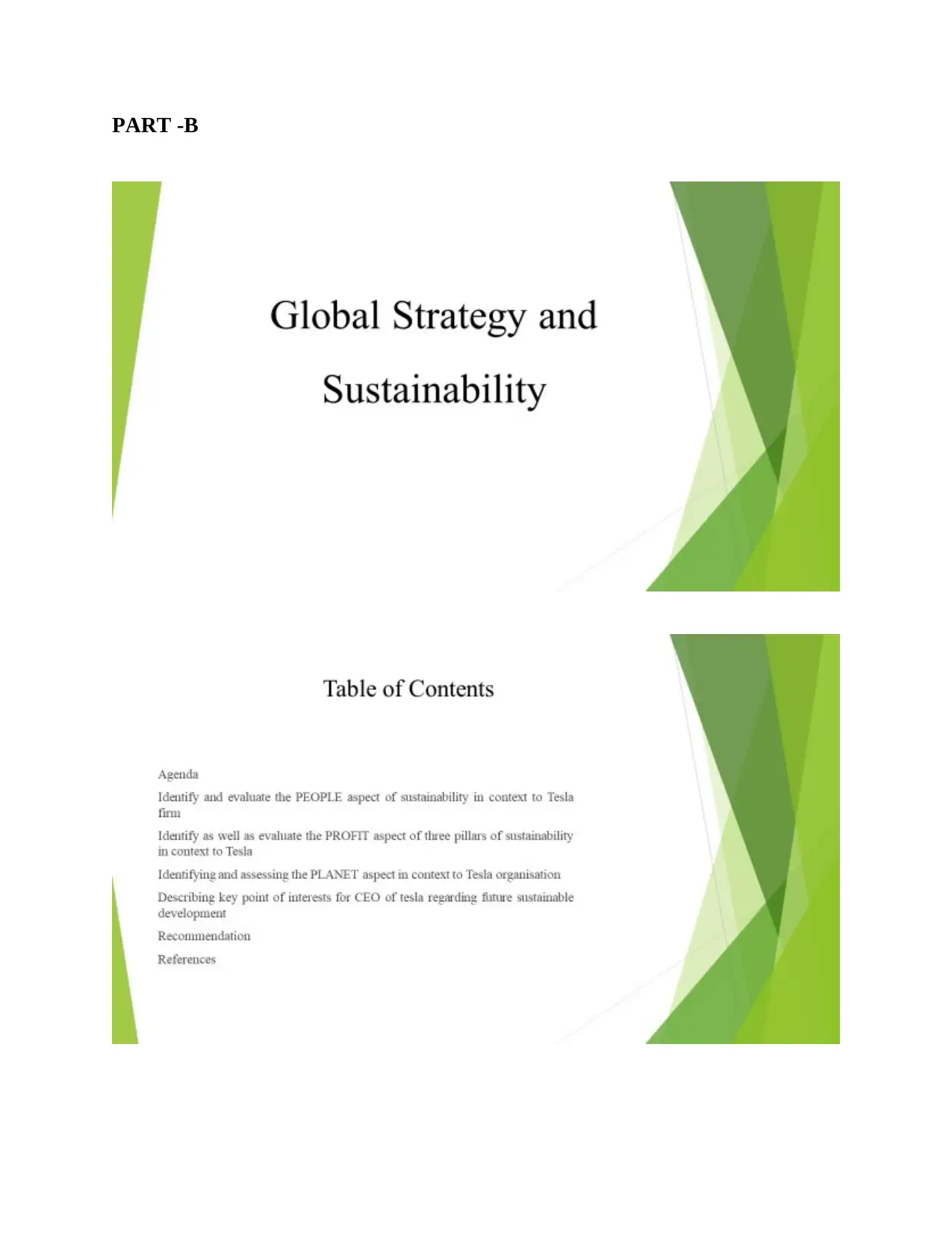
PART -B
Paraphrase This Document
Need a fresh take? Get an instant paraphrase of this document with our AI Paraphraser
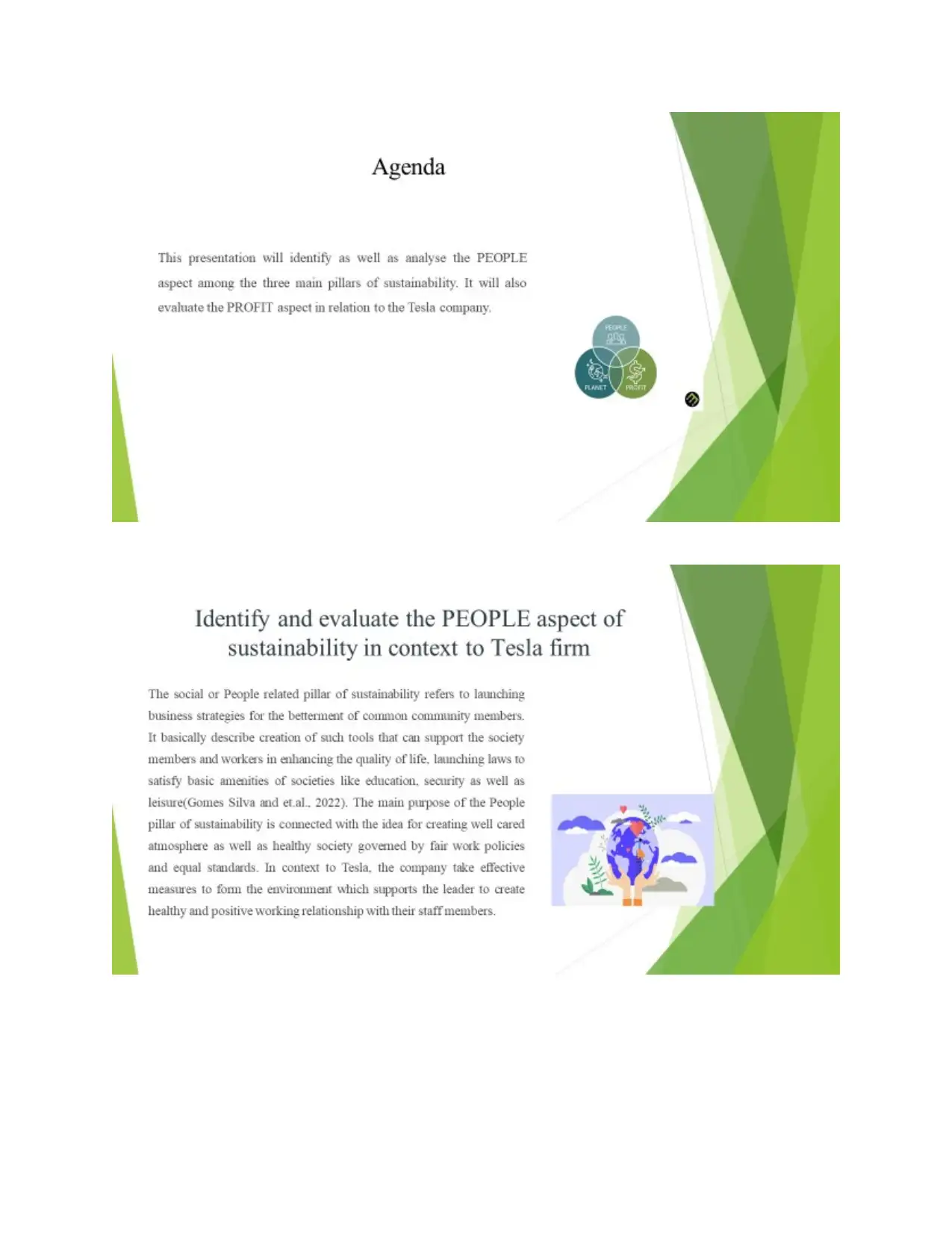
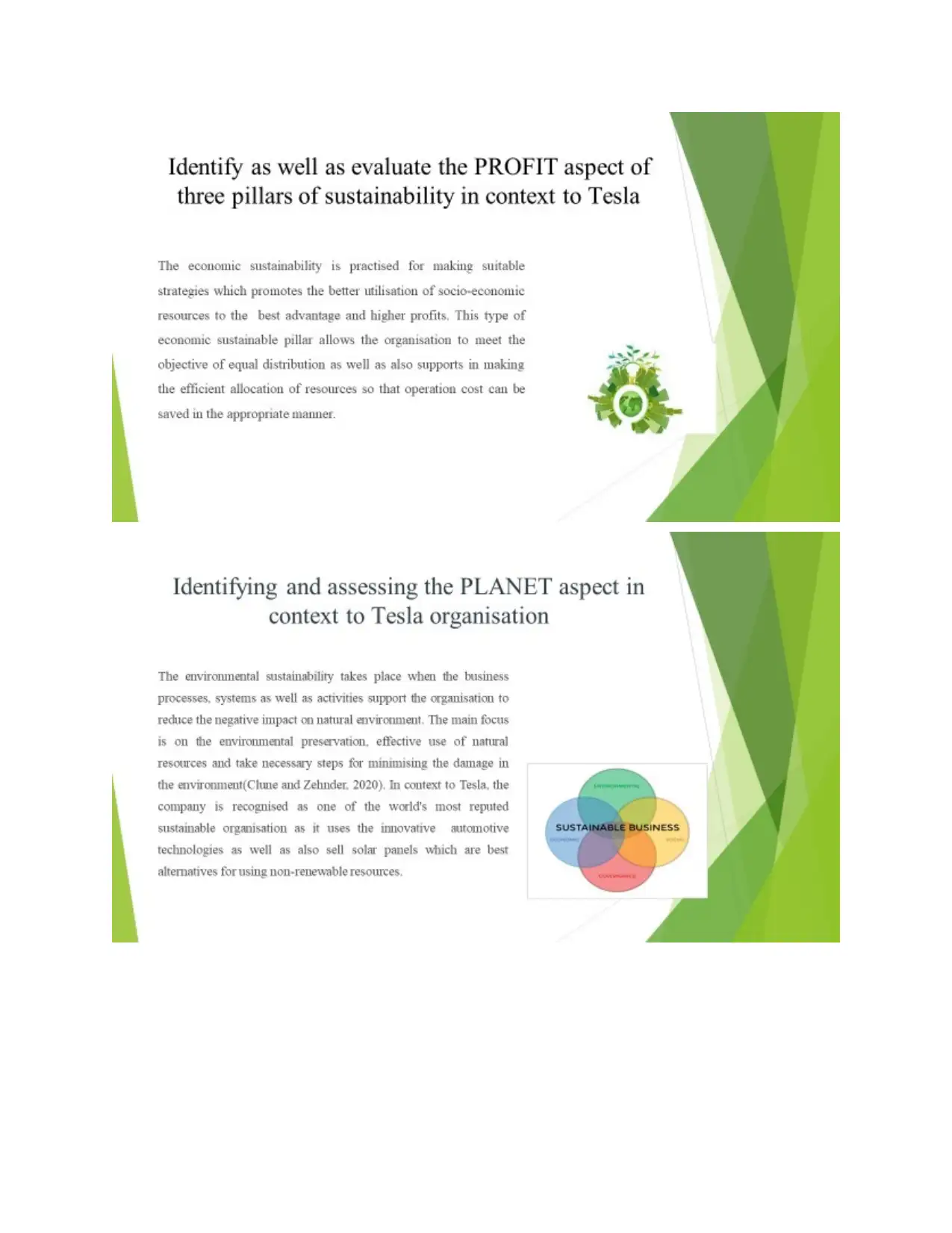
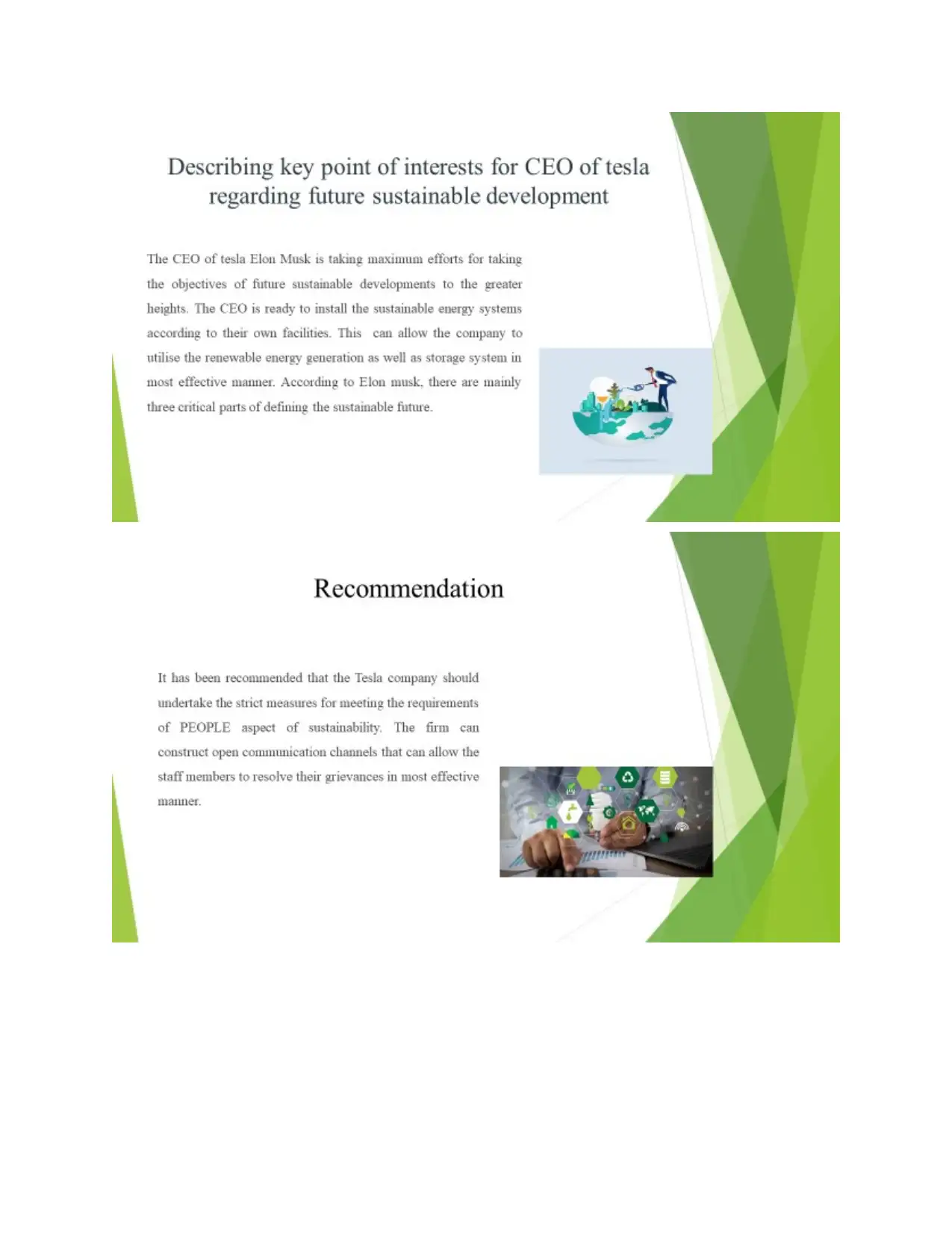
Secure Best Marks with AI Grader
Need help grading? Try our AI Grader for instant feedback on your assignments.
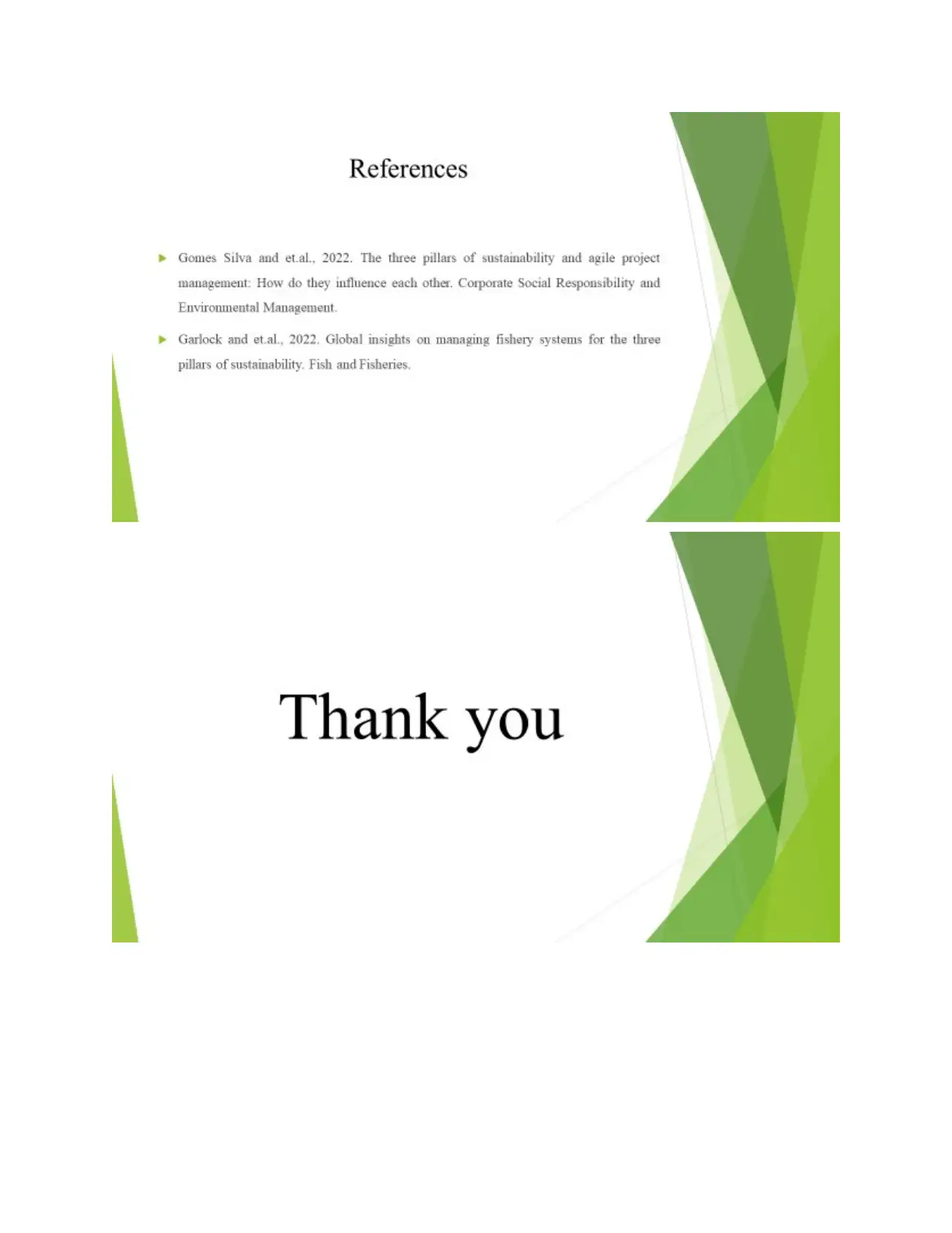


Paraphrase This Document
Need a fresh take? Get an instant paraphrase of this document with our AI Paraphraser

1 out of 20
Related Documents
Your All-in-One AI-Powered Toolkit for Academic Success.
+13062052269
info@desklib.com
Available 24*7 on WhatsApp / Email
![[object Object]](/_next/static/media/star-bottom.7253800d.svg)
Unlock your academic potential
© 2024 | Zucol Services PVT LTD | All rights reserved.





